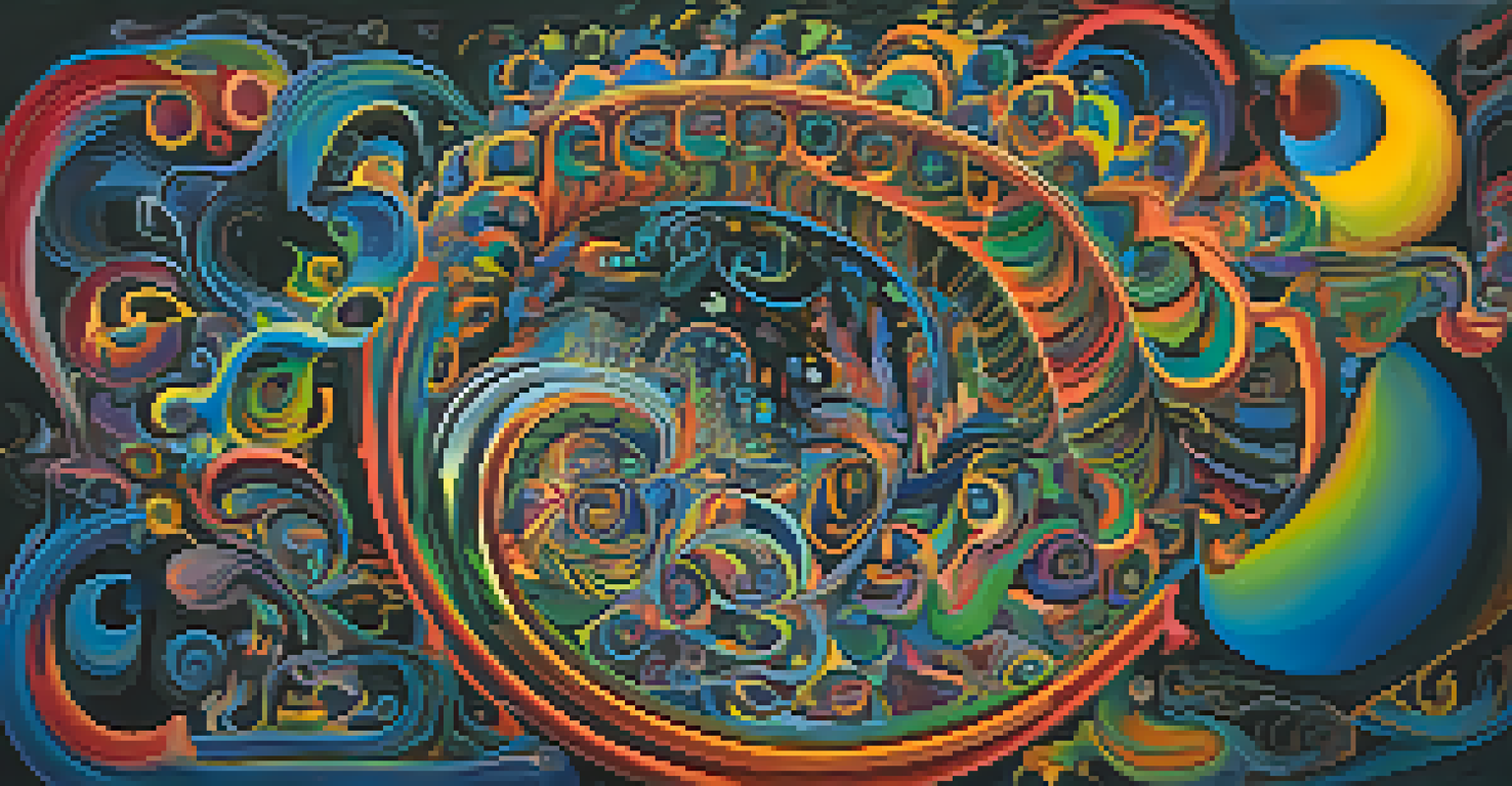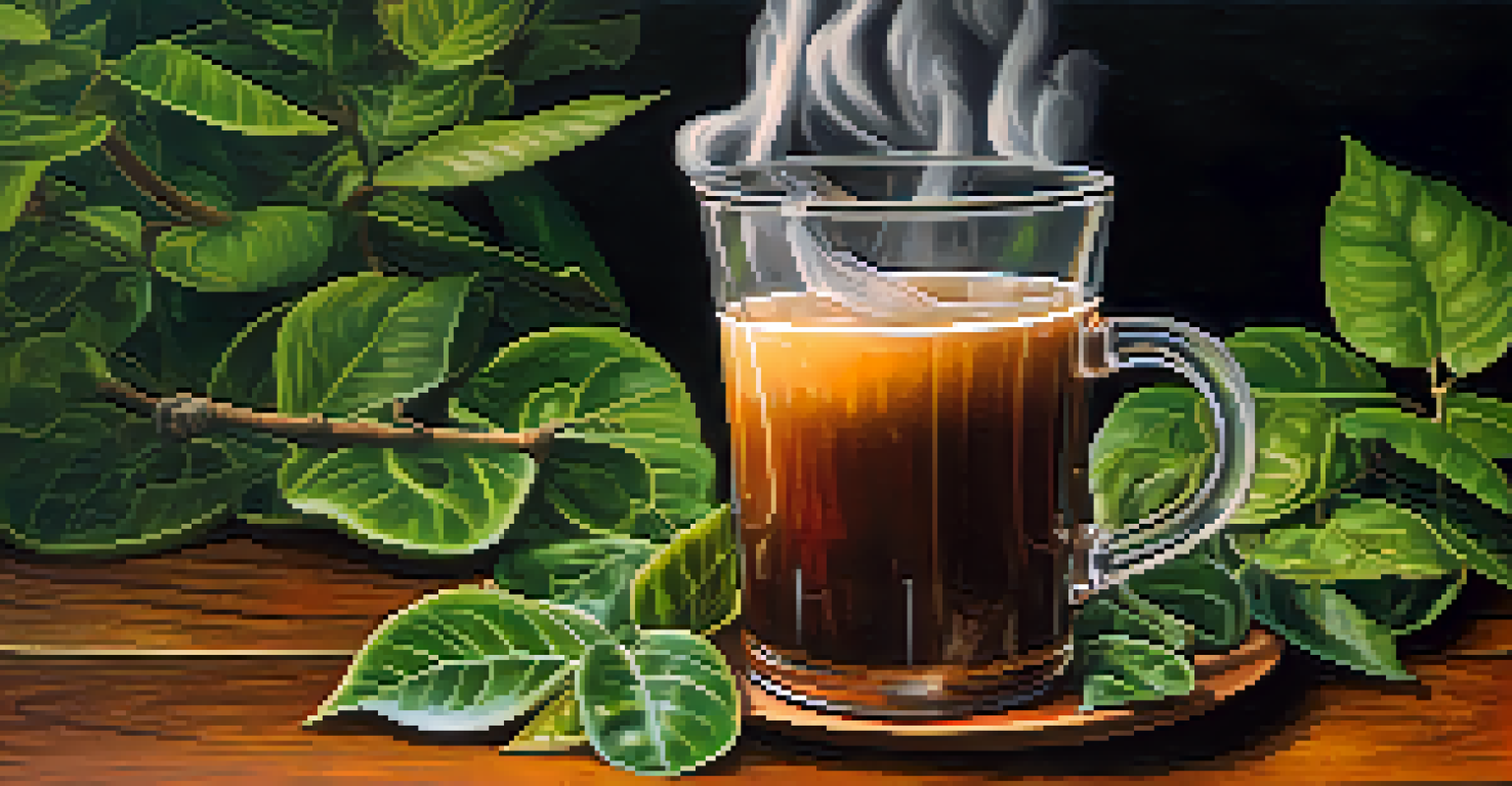Understanding the Mystical Experience with Ayahuasca

What is Ayahuasca and Its Origins?
Ayahuasca is a powerful plant medicine traditionally used by Indigenous tribes in the Amazon. Its primary ingredients are the Banisteriopsis caapi vine and the leaves of the Psychotria viridis plant, which together create a brew known for its hallucinogenic properties. This ancient potion has been utilized for centuries, not just for spiritual insights but also for healing purposes within various cultures.
The experience of Ayahuasca can be a profound journey into the self, revealing insights that often transform one's understanding of life.
The word 'Ayahuasca' translates to 'vine of the souls' in Quechua, and it's often consumed in ceremonial settings guided by a shaman. These shamans serve as spiritual guides, helping participants navigate their experiences. The setting is crucial, as it creates a safe space for individuals to explore their inner worlds.
As interest in Ayahuasca has grown globally, many people seek these experiences for personal growth, healing traumas, or simply to understand themselves better. However, it's essential to approach Ayahuasca with respect and awareness of its cultural significance.
Preparing for an Ayahuasca Journey
Preparation for an Ayahuasca journey involves both mental and physical readiness. Many practitioners suggest following a specific diet for a few weeks before the ceremony, often referred to as the 'dieta'. This typically includes avoiding alcohol, caffeine, and certain foods to help cleanse the body and prepare the mind.

Additionally, it's vital to set clear intentions before participating in the ceremony. What do you hope to gain from the experience? Having a focused intention can guide the journey and help you make sense of the insights that arise. Some might seek clarity on life choices, while others may aim to heal emotional wounds.
Ayahuasca: Origins and Significance
Ayahuasca, known as 'vine of the souls', is a traditional Amazonian brew used for spiritual and healing purposes under the guidance of Indigenous shamans.
Equally important is choosing the right setting and facilitator. A reputable shaman with experience can make a significant difference in the journey's outcome. It's wise to research and ensure you feel comfortable and safe in the environment where you'll be participating.
The Experience of Ayahuasca
The Ayahuasca experience can vary widely from person to person, often described as a journey into the self. Many participants report experiencing vivid visual and auditory hallucinations, deep introspection, and profound emotional releases. Some describe feelings of unity with nature and the universe, while others confront personal fears and traumas.
When we heal ourselves, we heal the world around us.
One common aspect of the experience is the feeling of purging, which can manifest physically through vomiting. While this can be uncomfortable, many view it as a therapeutic release of negative energy or emotions. This aspect underscores the importance of surrendering to the experience, allowing whatever arises to unfold naturally.
Throughout the journey, participants often encounter symbolic imagery or messages that resonate deeply with their personal lives. These revelations can lead to significant insights and a renewed sense of purpose, making the experience transformative in various ways.
Post-Journey Integration
After the Ayahuasca experience, integration becomes a crucial phase. This process involves reflecting on the insights gained during the journey and finding ways to incorporate them into daily life. Without proper integration, participants may struggle to make sense of their experiences, potentially leading to confusion or disillusionment.
Many individuals find it helpful to engage in journaling, therapy, or group discussions to process their experiences. Sharing insights with others who have undergone similar journeys can create a supportive community that fosters understanding and growth. It's important to allow time for these reflections to settle and evolve.
Preparation is Key for Ayahuasca
Preparing mentally and physically, including a specific diet and setting clear intentions, is crucial for a meaningful Ayahuasca journey.
Integration can also involve lifestyle changes, such as adopting mindfulness practices or exploring new spiritual paths. This phase is all about nurturing the seeds planted during the journey and allowing them to blossom in everyday life.
Potential Risks and Considerations
While many people have positive experiences with Ayahuasca, it's essential to be aware of potential risks. The brew can cause intense emotional and psychological reactions, which may be overwhelming for some. Individuals with a history of mental health issues should approach Ayahuasca with caution and consult with a healthcare professional beforehand.
Physical side effects, such as nausea and vomiting, are common but can be distressing. Therefore, understanding your body's responses and knowing what to expect can help mitigate these concerns. It's also crucial to ensure that the ceremony is conducted in a safe and controlled environment.
Lastly, there's a risk of cultural appropriation. Engaging with Ayahuasca should come from a place of respect for its Indigenous roots, and it's vital to honor the traditions and practices associated with its use. Seeking out authentic experiences led by Indigenous practitioners can help maintain this respect.
The Spiritual Significance of Ayahuasca
For many, Ayahuasca serves as a bridge to the spiritual realm. Participants often report feelings of connectedness to a higher power or the universe, leading to deeper spiritual insights. This can reinforce a sense of purpose, belonging, and understanding of one’s role within the larger tapestry of life.
These spiritual experiences can vary widely, from feelings of unconditional love to encounters with spiritual entities or guides. Such experiences can profoundly impact one's worldview and foster a greater appreciation for life and nature. They often lead to shifts in personal beliefs and values, encouraging individuals to explore their spirituality more deeply.
Integration After the Journey
Post-journey integration is essential for reflecting on insights gained and incorporating them into daily life for personal growth.
The spiritual journey doesn't necessarily end with the ceremony; instead, it often ignites a lifelong quest for knowledge and understanding. Many who partake in Ayahuasca find themselves drawn to other spiritual practices, seeking a more profound connection to themselves and the world around them.
Personal Testimonials and Stories
Hearing personal stories from those who have experienced Ayahuasca can provide invaluable insights. Many individuals recount transformative experiences that have changed their lives in profound ways. For instance, one participant described a journey where they confronted deep-seated fears, leading to a newfound sense of courage and clarity in their life path.
Another common theme is the feeling of interconnectedness with others during the experience. Many report a sense of unity, not just with nature but also with fellow participants, fostering deep bonds that can last long after the ceremony. These connections often create a supportive community, helping individuals feel less isolated in their experiences.

These testimonials highlight the deeply personal nature of Ayahuasca journeys, reminding us that each experience is unique. They also emphasize the importance of approaching the journey with an open heart and mind, ready to embrace whatever insights may arise.